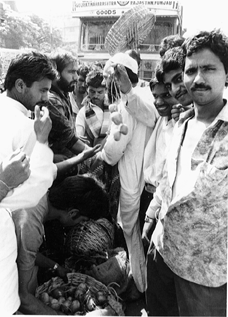
Exchange to India
Gregg Ferguson
The three-wheeled, smoke-belching auto-rickshaw carrying me crashes back
down to a more or less level orientation and once again accelerates. The
driver's smile and joyous eyes are framed by the mirror, seeking my approval
for the incredible skills he has honed. Years ago, I raced somewhat similar
vehicles at amazing speeds - in fact almost 240 km/hr faster than I was now
moving - and so could relate to his nerve and concentration. Why then, was
I leaving finger marks of terror in the steel holds as we wildly swerved
through oxen, camels, countless bicycles, people, cars, dense smog, and even
the just avoided elephant. I kept telling myself that it was because I was
tired; I'd just arrived in Ahmedabad, India after traveling for 36 hours
straight and finishing Studio presentations in Calgary. After all, it was
only 7:00am on a Sunday morning in Ahmedabad; what was it going to be like
in rush-hour?
There has to be a bit of stereotypical culture-shock content with every story
about a student-exchange to an exotic land, and with my recent trip to India,
there was plenty of material. The rest can be saved for cocktail chatter
as it would really demean the overall experience. From December ''94 through
May 95, I was the EVDS participant in an exchange programme with the School
of Architecture at the Centre of Environmental Planning and Technology in
Ahmedabad, Gujuarat. The CEPT programme has been in place for a number of
years, and besides interacting with the U of C, it also is taken advantage
formally by students from TU Delft, the ETH in Zurich, and other architectural
schools in Vienna, Germany, and Denmark. Last semester in fact saw 14
international students working along side 32 Indian students in the senior
studio of the country's most prestigious design school.

This semester-long studio is oriented around a single urban design project;
students have a choice of one of four specific projects ranging from urban
housing to large scale redevelopment, led by four different professors and
their assistants. My own choice was the redevelopment of the historic produce
market in Bombay, located on a huge site in the centre of the incredibly
dense fabric of that peninsular city. The project put me face to face with
the realities of the Indian urban situation and provided a great window into
life in this country - encompassing far more than just architecture. Site
visits, a week at a time, were overwhelming. My guide through the semester,
Professor Chhaya, encouraged an intensive exploration and forced our eyes
open to see far more than what existed on the surface; visits into the market
at 3:00 am, for instance, revealed that thousands of the day labourers in
fact made the site their home. Space in India represents potential and there
are no shortage of users. I also took two other courses: Shell/surface Structures
and Light-weight Structures - areas in which CEPT's faculty has great strength.
Educational opportunity isn't the only reason one goes on an exchange to
India; there is plenty more. The culture is fascinating, and the school's
tight links to Ahmedabad enrich one's experience of it. Several large cultural
festivals are centred on campus each term and are attended by tens of thousands.
CEPT is also a cross-roads of sorts for architectural and planning thought
in India and there are several presentations each week by visiting scholars
and practitioners from all parts of the globe, including, much to my surprise,
one by Bill Semple, a recent architecture grad from EVDS. The social scene
on campus is intense, with hourly trips for chai or coffee to numerous roof-top
soirees above our studio, designed by Doshi, India's leading architect, who
seems to truly understand his users. One definitely feels welcome at CEPT.
A small Indian city at 4.5 million, arid and dusty, Ahmedabad has far more
to offer than the scene that greeted my arrival. Some of India's most interesting
and dense pre-colonial housing, excellent examples of Modern architecture,
including works by Le Corbusier and Kahn, and recent work by the country's
best are to be found here. The city is also home to examples of unique stepwells
built by the Mogul rulers in the 12th and 13th centuries. These structures
resemble inverted temples built to nine stories deep in the ground, and are
designed to catch monsoon rainfall and store it for the rest of the year,
while allowing access to the surface as the water level drops. Ghandi's Ashram,
seems to attract other prominent visitors, including Nelson Mandela, who
delivered a very non-architectural chat one day to a intimate group of 20,000.
There's just too much to do once you start poking through the chaos and dust.
The exchange programme is ongoing and in January, you can expect to see another
somewhat lost and frozen looking individual from CEPT in the EVDS studio.
The corresponding position in India provides an incredible opportunity to
experience one of the richest places on earth in a unique fashion. If you
want more information on the possibilities of attending CEPT, contact Graham
Livesey or myself. As well, I will be putting on at least one slide presentation
on the trip soon and in Structures III in the winter 96 term, and will present
a synopsis of the Surface/shell and Lightweight Structures courses. As former
CEPT exchange student Tanuj Goenka would say, "Good fun!"

Above: Gregg on the studio roof with other international students
Above right: Bombay Market
[ Top of Page | Table of Contents | Intervention | Previous Article | Next Article ]